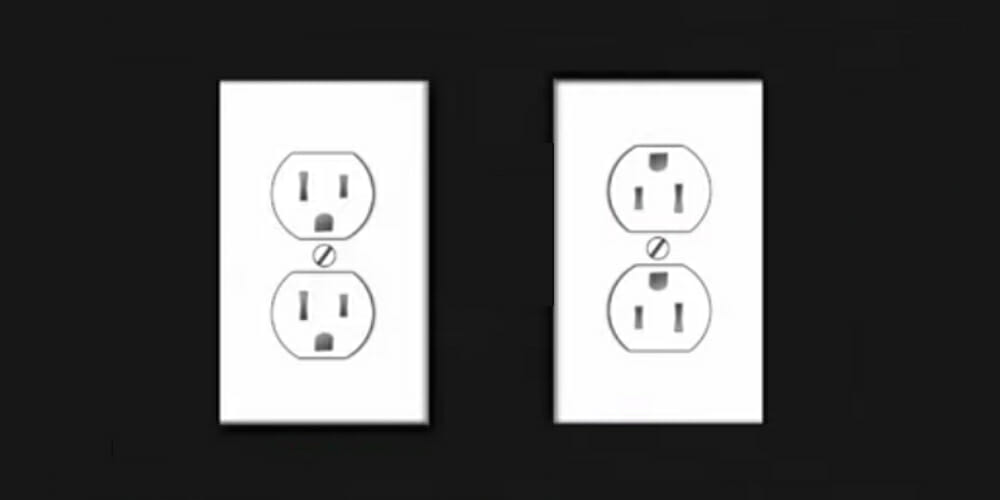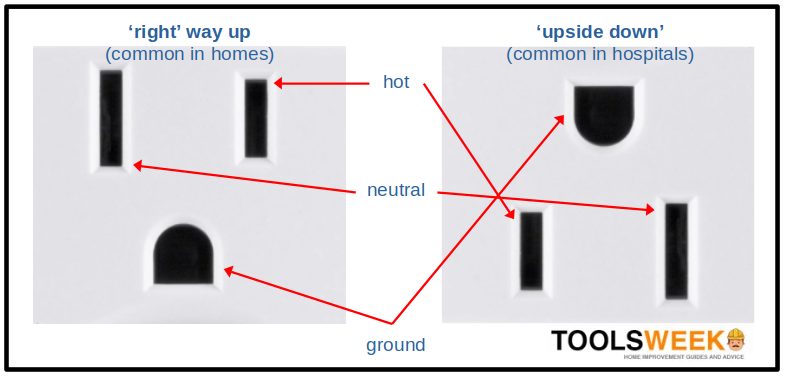Why are Outlets Upside Down in Hospitals? (Guide)

Have you ever walked through a hospital and noticed those outlets flipped upside down? Yeah, I’ve seen that, too, and let me tell you, there’s a pretty smart reason behind it.
When outlets are installed upside down, it’s all about cranking up the safety. Imagine you’ve got a metallic object that accidentally falls onto an outlet that’s only halfway plugged in. The object won’t hit the live pins if that outlet is upside down. It’s a simple twist, but it makes a huge difference.
In this article, we’re diving deeper into why those upside-down outlets in hospitals are more than just a design quirk – they’re a crucial safety feature.
Right Way Up vs. Upside Down: The Outlet Lowdown

Let’s break down the real difference between standard and upside-down outlets. It’s like taking a behind-the-scenes look at what’s happening inside those walls!
Standard Outlet Orientation (Right Way Up)
- Position: Live and neutral slots at the top, ground connection at the bottom.
- What Happens When Something Falls? A metal object could hit the hot and neutral prongs if it drops.
- Risks: This could cause a short circuit. Think of it like accidentally crossing wires – it’s a recipe for trouble.
- Internal Damage: If an object hits hard enough, it might mess with the internal wiring. If the wires get pinched or cut, this could lead to a short circuit. It’s like hitting a nerve – things go haywire.
Upside-Down Outlet Orientation (Safety First)
- Position: Ground slot at the top, live and neutral slots at the bottom.
- What Happens When Something Falls?: Objects hit the ground prong first.
- Risks: There is a much lower chance of a short circuit. It’s like having a safety net up there.
- Internal Security: Less likely to damage internal wiring or cause shifts in the outlet. It keeps everything snug and secures how we like it.
What Could Go Wrong with Right-Side-Up Outlets?
- Wiring Damage: Something hits the outlet, and the internal wiring gets compromised – a classic short circuit scenario.
- Loose Connections: An impact might jiggle things around inside, leading to loose connections. Loose connections are like shaky foundations – they can lead to electrical arcing, sparking a potential short circuit.
- Power Overload: If the impact makes a device come unplugged while others are still running, it’s like a sudden surge in a crowded room. The remaining devices might draw too much power, leading to an overload and, you guessed it, a short circuit.
Remember, it’s not just about plugging things in. How outlets are installed can make a big difference in safety, especially in places like hospitals where every precaution counts. It’s all about understanding the layout and playing it safe!
Flipping the Script on Safety: The Upside-Down Outlets in Hospitals

Let’s dive into a fascinating aspect of hospital safety – those upside-down electrical outlets. It’s like flipping a safety strategy on its head, literally!
The Standard Scenario in Hospitals
I’ve seen my fair share of hospitals from working on various projects. One thing that’s always around? Metallic tools and instruments. And traditionally, most outlets you see are right-side-up.
Imagine a metallic tool slipping from someone’s hand. If that tool hits a half-plugged device’s hot or neutral prongs, you’ve got trouble brewing. It’s not just a tiny zap; it’s a full-blown fire hazard in a place where safety is paramount.
Why Upside-Down Makes Sense
So, hospitals started getting smart about this. They began installing outlets with the ground prong at the top.
If a tool now falls, it’s more likely to strike the grounded part first. This simple flip reduces the risk of short circuits big time. It’s like having a safety net in place.
In hospitals, it’s all about managing chaos while keeping safety at the forefront. They’re high-energy places with a constant buzz of activity and devices.
By having outlets upside down, the likelihood of electrical mishaps drops significantly. This is a huge deal in these environments where every second and detail counts.
It’s about crafting an environment where healthcare professionals can concentrate on what they do best – saving lives without the added worry of electrical dangers. This is one of those times when a simple tweak in design can make a world of difference in operational safety and efficiency.
Comparative Analysis: Safety Measures in Different Buildings
Let’s dive into a fascinating comparison of electrical safety measures across various buildings – homes, offices, and hospitals. It’s like looking at how different settings require unique solutions to keep everyone safe.
| Building Type | Outlets | Safety Features | Unique Aspect |
|---|---|---|---|
| Homes | Typically, it is right-side-up to match common use and aesthetics. | Circuit breakers and GFCI in wet areas like bathrooms and kitchens to prevent shocks. | The focus here is on balancing safety with simplicity and cost-effectiveness. We’re looking at keeping families safe in a straightforward, user-friendly way. |
| Offices | Varies based on layout and equipment needs, not a one-size-fits-all approach. | Surge protectors for sensitive electronics, emergency lighting, and advanced fire alarm systems in some cases. | In office spaces, it’s all about blending safety with functionality. We need to ensure a safe working environment that keeps up with the hustle of office electronics. |
| Hospitals | Often upside-down, particularly in areas where patient care is critical. | Features like red outlets for emergency power, adherence to strict electrical codes, and regular safety inspections are common. | Hospitals are a whole different ball game. Every detail, including the orientation of outlets, is geared towards maximizing patient safety and ensuring that life-saving equipment operates without a hitch during emergencies. |
While homes focus on basic safety and comfort, offices step it up with a blend of functionality and compliance. But hospitals? They’re in a league with safety measures tailored to protect patients and life-saving equipment.
Frequently Asked Questions
- Can I Install Upside-Down Outlets in My Home?
- You bet! While it’s more common in hospitals, there’s no rule against having them at home. If you think it adds an extra layer of safety, especially in areas where metal objects might fall, go for it!
- Are Red Outlets in Hospitals Different from Regular Ones?
- Yes, indeed! Red outlets are special – they’re connected to emergency power. If there’s a power outage, these outlets keep critical equipment running. It’s like having a safety net for the most essential gadgets.
- How Often Are Hospital Electrical Systems Inspected?
- Hospital electrical systems are checked way more frequently than in homes or offices. The exact frequency can vary, but the idea is to ensure everything is in top-notch condition and always ready for emergencies.
- Is It Safe to Use Personal Electronic Devices in Hospitals?
- Generally, yes, but always follow hospital guidelines. Some areas might restrict use due to potential interference with medical equipment. It’s always best to check with hospital staff.
References
Organizations:
- National Research Council Canada (NRC). https://nrc.canada.ca/en
- Occupational Safety and Health Administration (OSHA). https://www.osha.gov/
- National Fire Protection Association (NFPA). https://www.nfpa.org/en
Books:
- “Electrical Safety in Health Care Facilities” by Herbert H. Roth. https://www-origin.abebooks.com/servlet/BookDetailsPL?bi=3115534583
- “Electrical Safety in Healthcare Facilities: Clarifying the Standards. https://energy5.com/electrical-safety-in-healthcare-facilities-regulatory-requirements
Website Resources:
- The Electricity Forum. https://www.electricityforum.com/
- OSHA. https://www.osha.gov/
- NFPA. https://www.nfpa.org/en
